No two week holiday for us this year after the big flood in the kitchen, which set off waves of extra building works. But finally we had new floors and the end of six months ‘camping’ in dusty chaos was in sight. What about a few days deep in the countryside, exploring the Somerset Levels? This was an appealing suggestion. Luckily, we have a cousin in that part of the world and he encouraged us to come and visit.
Enjoyable to be with Simon and family in their extraordinary mansion, complete with lake, ducks, hens, beehives and aquarium,

Anyone for cricket? Weekend Somerset team

Simon’s herbaceous border
Our first foray into this old English county was to the ancient city of Wells – water sources, of which there are many, bubble up within the Bishop’s Palace garden. The last time I was there, about thirty years ago, we took an American cousin with us and ended up sitting on the grass, eating a surfeit of mulberries. So rich and sweet, unctuous like home made jam, loaded with fruit. Our sticky fingers were stained purple – a royal colour.
Wells, though called a city, is small. And very beautiful. The centre is for pedestrians only. I decided I could live here (for a while). We found a great restaurant on a terrace in the sun for lunch, just behind the elegant ‘Swan’ hotel. A satisfactory mooch about Waterstones netted a book on ‘King Alfred The Great’ by Justin Pollard. Later on, we were able to visit his memorial stone at the side of a wheatfield, where we met the farmer, who was over eighty years old.
But the highlight here was the return visit to the Bishop’s Palace garden. Cousin Hollister is long gone but does something of him remain here? Do memories have weight that is invisibly left behind? Probably not – could dark matter or dark energy be the invisible weight of thought? It has been mooted in the scientific world.

Wells cathedral and Bishop’s Palace garden …

The monk’s welcome … giving alms … ?
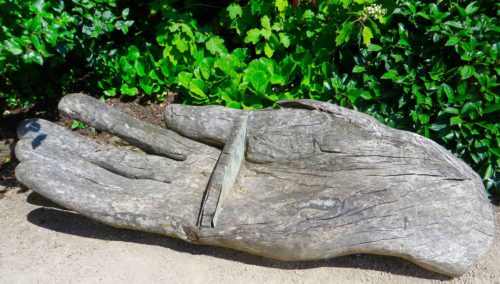
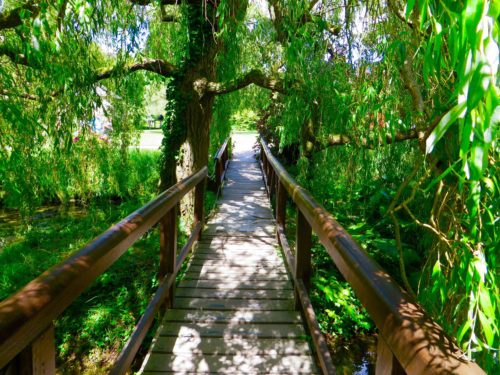
‘Make me a willow cabin at your gate’ … (Shakespeare – Twelfth Night)
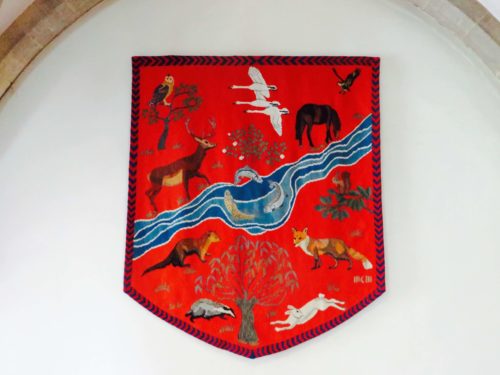
Bishop’s Palace, Wells – Animals

Bishop’s Palace, Wells – Swans
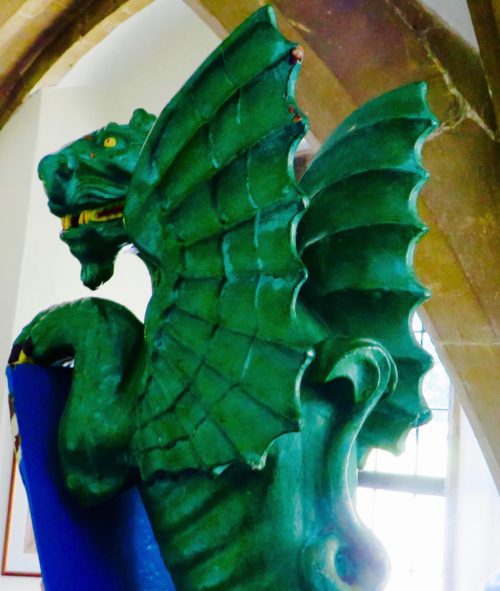
Monster in the Bishop’s Palace
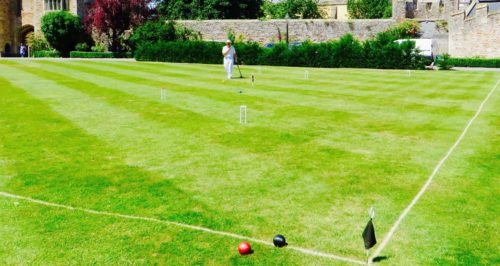
Croquet in the Palace gardens

… Crocosmia ‘Lucifer’…
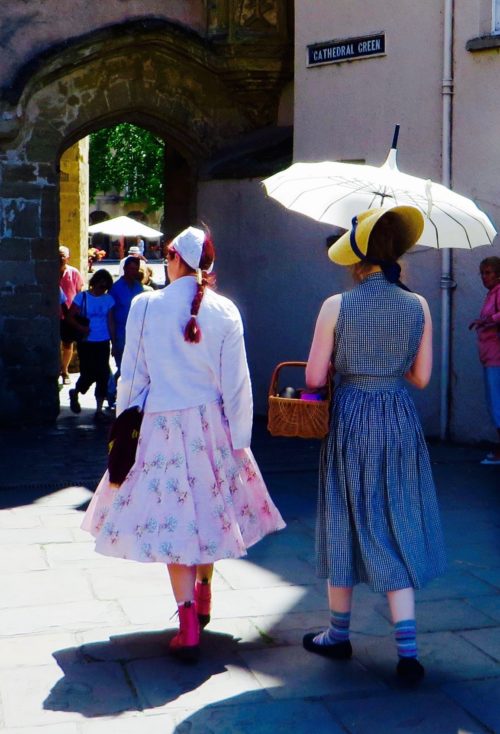
Wells – two interesting visitors …

Wells cathedral – altarcloth
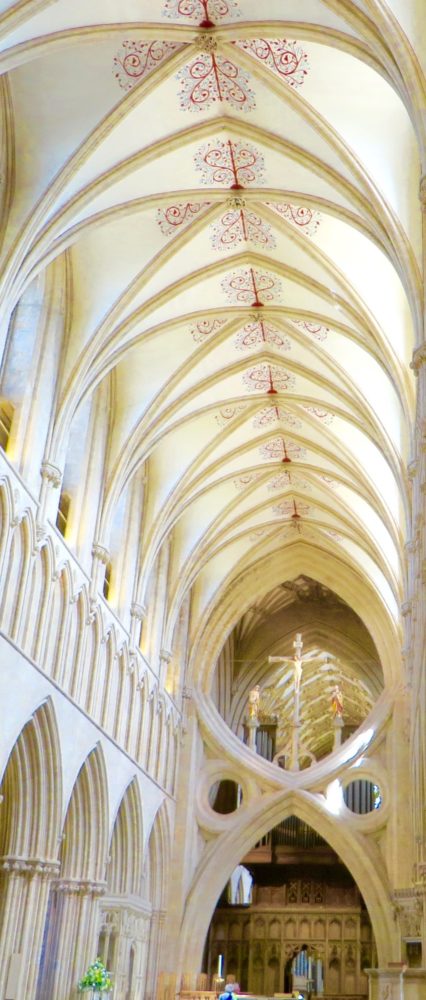
Wells cathedral – ceiling

..and another ceiling …
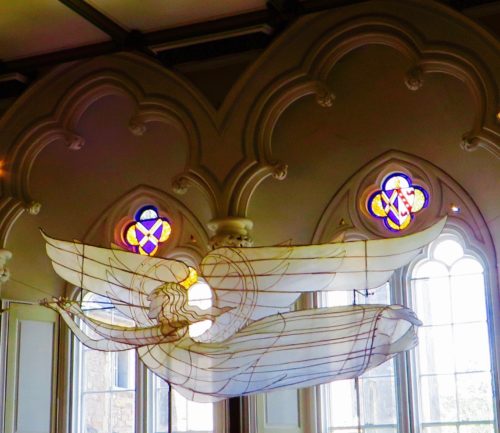
Wells – an angel caught in flight …

A careworn yet beautifully expressive face …
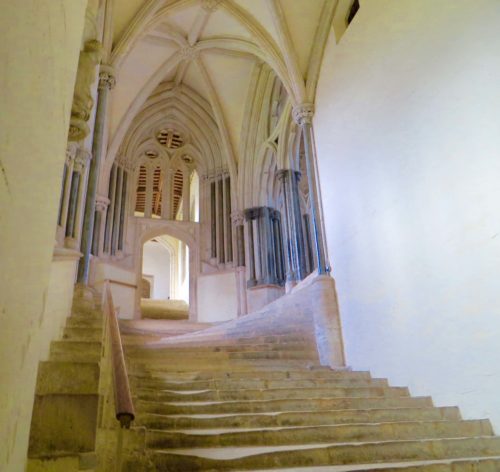
Wells cathedral – well worn steps …

Wells – a most ancient tree
We were feeling rather ancient ourselves by the end of the day. Supper was waiting at Simon’s with the welcome of a comfortable bed.
Next day we left for the Somerset Levels and our Alastair Sawday recommendation – Brook Farm, North Curry. This turned out to be a great choice. Five stars!
Our hostess makes delicious jams and marmalade, so breakfast was a special treat. She has such a good eye with paintings and curious, interesting objects picked up at auctions and obviously loves beautiful, old things.

Our exquisite bedspread …
We set off early next morning to explore the Somerset Levels, dropping in to Glastonbury on the way.

Glastonbury Tor
We had planned to climb up to the top of the Tor but it began to rain and there were a few too many ‘crystal’ shops lining the high street so we bought a santolina plant in the market before retreating to pastures new.
The rain turned into a downpour, We saw a signpost to Mulchenly Abbey, an erstwhile Benedictine monastery established in the 12th century and made our way in as much for shelter as for history.
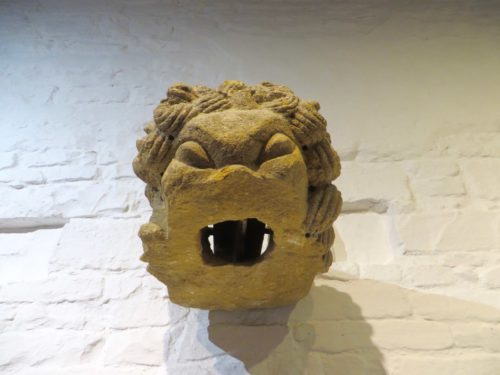
A welcome of sorts …
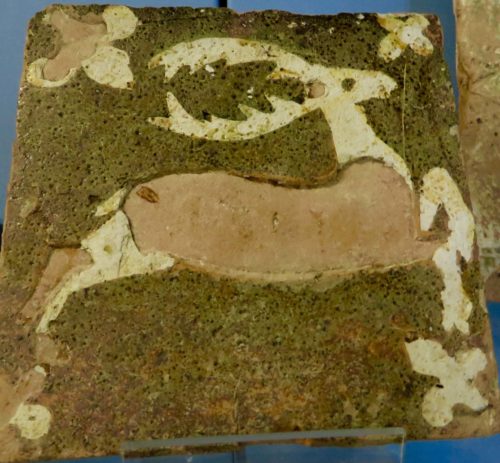
Ancient artefacts
The Abbey was a focal point in the otherwise marshy and often flooded fields of the Somerset Levels. It’s worth a visit. There’s a small shop at the entrance where we bought two bottles of mead – an offering from monks of long ago …
Reed beds abound and the reeds are used for basket making and sculptures. We stopped by a place near Brook Farm to investigate further.
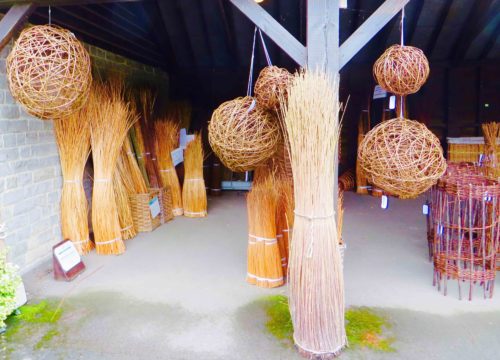
Reed weavers shed
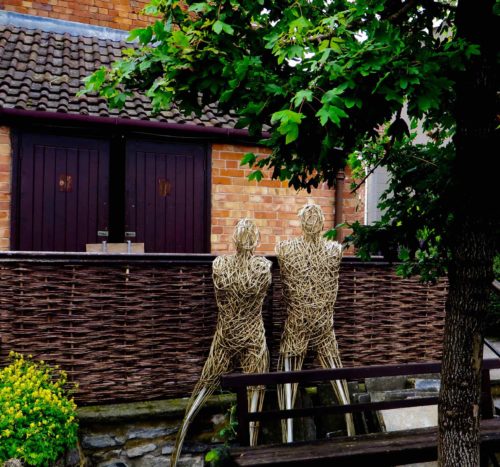
Reed people …

The giant’s enormously useful watering can …?!
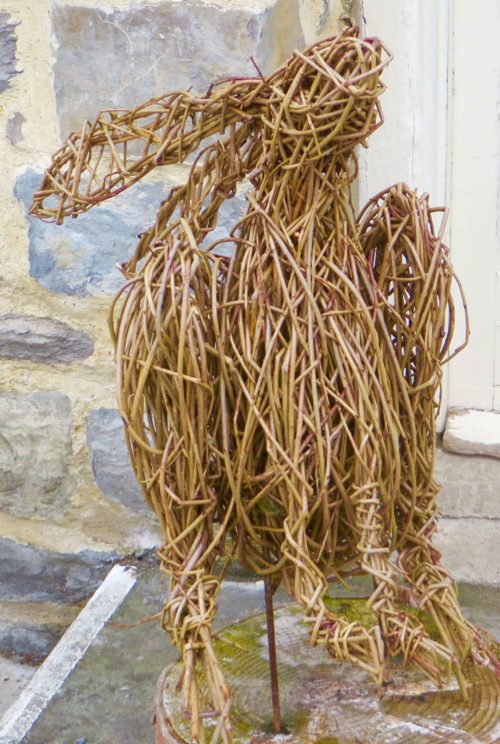
A ‘painterly’ hare
There are many hares on the Greylake Nature Reserve. Also a large heronry at Swell Wood (150 nests). 100 cranes were recently reintroduced to the Somerset Levels after 400 years – the best time to see them is in winter. And at Ham Wall Nature Reserve you will find murmurations of starlings at certain times of the year. Look up ‘The Great Crane Project’ for further information on wildlife.

The old and the new – solar sheep …
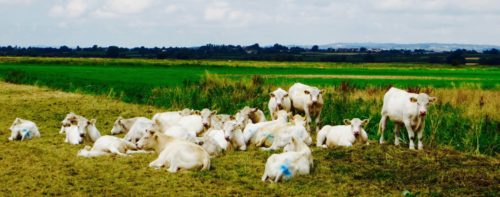
Creamy cows on the Somerset Levels
Next morning the rain had cleared. Breakfast was in doubt as an ambulance arrived at Brook Farm. A man bringing gas cylinders had disturbed a nest of wasps and was badly stung. He later recovered in hospital. Meanwhile, breakfast went ahead.
A panoramic view of the Somerset Levels can be found by climbing a small but perfectly formed hill, with a ruined church on the top called Burrow Mump. It’s very near the road and easy to park. We were blown up there by gusts of wind! Next stop Langport – a fascinating small town with the river Parrett at the far end of the high street. There’s an easy walk along the river to Mulcheny Abbey with a return trip along a disused railway line.

Recycled boat by the river Parrett
Rather a lot of teashops abound and we found ourselves in the Kitchen Café by Bow Wharf surrounded by delicious cakes. Works by local artists on the walls.
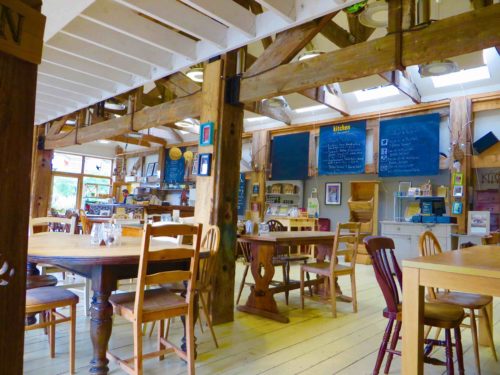
Kitchen café by Bow Wharf, Langport
I was attracted to an artwork which must have been a printed collage surrounded by ‘things recycled’ – like bottle tops. There are artists who make pictures out of recycled ‘stuff’ – it’s an interesting concept.
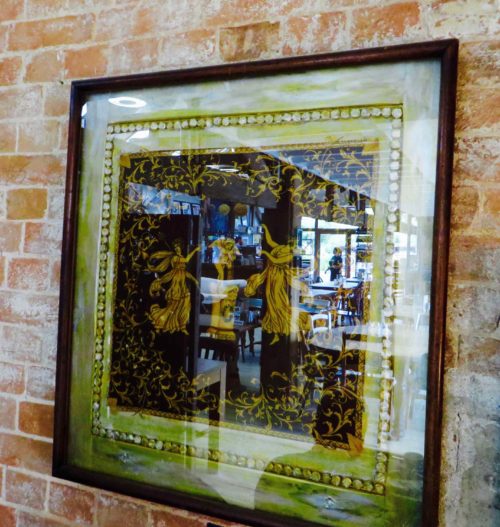
Intriguing …
Across the road by the river – with another tempting café – we came upon the Shakspeare Glass Blowing and Arts Centre. A lovely visit produced this to take home with us!

From the Shakspeare Glass and Arts centre, Langport, Somerset
We had to press on (no more cake!) as John wanted to find a memorial to King Alfred at Athelney. Alfred the Great, who lived and died in the 9th century, is known to us for ‘burning the cakes’ but ‘his campaign was unique, waged not merely with weapons, but with a vision of a new type of kingdom, where protection and prosperity resulted not from physical force alone, but from education, public building, commerce and law’. He was far sighted. This quote comes from the book ‘Alfred The Great – The Man Who Made England’ by Justin Pollard (2005).

King Alfred The Great …
We finally tracked down the memorial, which is on a hillock in a wheatfield. The 80 year old farmer, who we met and chatted with, looked very Anglo-Saxon.
Our time was up – time to say ‘au revoir’ to a beautiful and fascinating part of England.
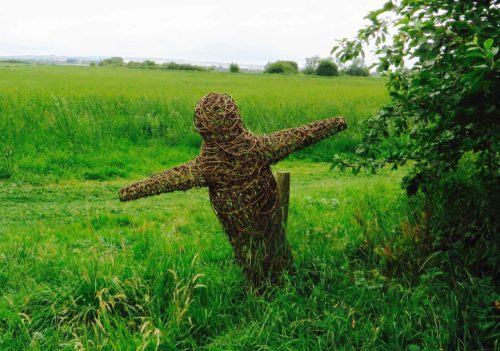
The Somerset Levels – a place to return to …

Homeward bound
P.S.
Should I resort to a new phone with a great camera? I probably will but meanwhile, my Canon is serving me well.
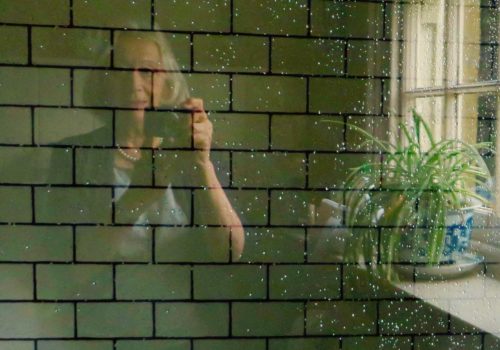
happy days …
